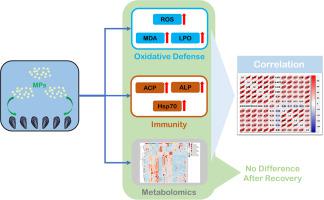Journal of Hazardous Materials ( IF 12.2 ) Pub Date : 2021-05-05 , DOI: 10.1016/j.jhazmat.2021.126003 Wei Huang 1 , Xinghuo Wang 2 , Deying Chen 3 , Elvis Genbo Xu 4 , Xian Luo 5 , Jiangning Zeng 6 , Tao Huan 7 , Liang Li 5 , Youji Wang 8

|
Marine microplastic has become an important environmental issue of global concern due to its wide distribution and harmful impacts. However, there is still insufficient information on the toxicity mechanism of microplastics to marine organisms. In this study, we developed and applied a high-coverage quantitative metabolomics technique to investigate the toxicity mechanisms of the polystyrene microspheres (micro-PS) on marine mussels (Mytilus coruscus). A total of 3599 metabolites were quantified, including 163 positively identified metabolites, 318 high-confident putatively identified metabolites, and 2602 mass-matched metabolites from the hemolymph of mussels. Metabolomics analysis indicated that micro-PS disrupted the amino acid metabolism, particularly phenylalanine metabolism, which may lead to oxidative stress and neurotoxicity. Micro-PS at environmentally relevant concentrations induced oxidative stress and immunotoxicity in mussels. After 7 days of recovery, along with the significant clearance of micro-PS by mussels, both metabolite levels and biochemical indicators generally returned to the same level as the control group. Overall, the results showed that microplastics at environmentally-relevant concentrations can cause toxic effects on mussels but these influences are reversible. We envisage the usages of high-coverage metabolomics for investigating the toxicity of various types of microplastics under many different conditions, including those relevant to the marine environment.
中文翻译:

化学同位素标记液相色谱质谱法高覆盖定量代谢组学揭示了海洋贻贝中聚苯乙烯微塑料的毒性机理
海洋微塑料由于其广泛的分布和有害影响而已成为全球关注的重要环境问题。但是,关于微塑料对海洋生物的毒性机理的信息仍然不足。在这项研究中,我们开发并应用了一种高覆盖率定量代谢组学技术来研究聚苯乙烯微球(micro-PS)对海洋贻贝(Mytilus coruscus)的毒性机理。)。总共对3599种代谢产物进行了定量,包括163种经阳性鉴定的代谢产物,318种高度可信的经推定鉴定的代谢产物和2602种贻贝血淋巴中的质量匹配代谢产物。代谢组学分析表明,微PS破坏了氨基酸代谢,特别是苯丙氨酸代谢,可能导致氧化应激和神经毒性。与环境相关浓度的微型PS会引起贻贝的氧化应激和免疫毒性。恢复7天后,连同贻贝对micro-PS的明显清除,代谢物水平和生化指标通常都恢复到与对照组相同的水平。总体而言,结果表明,与环境相关浓度的微塑料可能对贻贝产生毒性作用,但这些影响是可逆的。











































 京公网安备 11010802027423号
京公网安备 11010802027423号